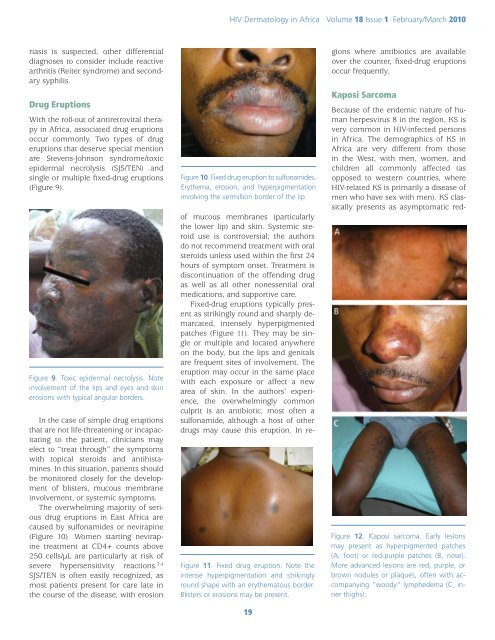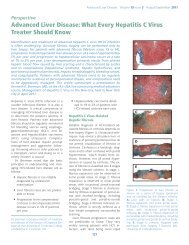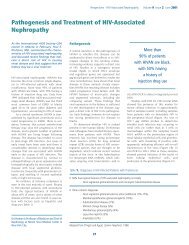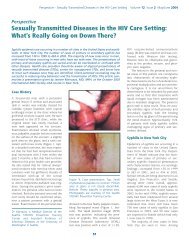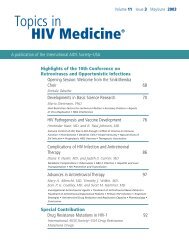Dermatologic Manifestations of HIV in Africa - International AIDS ...
Dermatologic Manifestations of HIV in Africa - International AIDS ...
Dermatologic Manifestations of HIV in Africa - International AIDS ...
You also want an ePaper? Increase the reach of your titles
YUMPU automatically turns print PDFs into web optimized ePapers that Google loves.
<strong>HIV</strong> Dermatology <strong>in</strong> <strong>Africa</strong> Volume 18 Issue 1 February/March 2010<br />
riasis is suspected, other differential<br />
diagnoses to consider <strong>in</strong>clude reactive<br />
arthritis (Reiter syndrome) and secondary<br />
syphilis.<br />
Drug Eruptions<br />
With the roll-out <strong>of</strong> antiretroviral therapy<br />
<strong>in</strong> <strong>Africa</strong>, associated drug eruptions<br />
occur commonly. Two types <strong>of</strong> drug<br />
eruptions that deserve special mention<br />
are Stevens-Johnson syndrome/toxic<br />
epidermal necrolysis (SJS/TEN) and<br />
s<strong>in</strong>gle or multiple fixed-drug eruptions<br />
(Figure 9).<br />
Figure 9. Toxic epidermal necrolysis. Note<br />
<strong>in</strong>volvement <strong>of</strong> the lips and eyes and sk<strong>in</strong><br />
erosions with typical angular borders.<br />
In the case <strong>of</strong> simple drug eruptions<br />
that are not life-threaten<strong>in</strong>g or <strong>in</strong>capacitat<strong>in</strong>g<br />
to the patient, cl<strong>in</strong>icians may<br />
elect to “treat through” the symptoms<br />
with topical steroids and antihistam<strong>in</strong>es.<br />
In this situation, patients should<br />
be monitored closely for the development<br />
<strong>of</strong> blisters, mucous membrane<br />
<strong>in</strong>volvement, or systemic symptoms.<br />
The overwhelm<strong>in</strong>g majority <strong>of</strong> serious<br />
drug eruptions <strong>in</strong> East <strong>Africa</strong> are<br />
caused by sulfonamides or nevirap<strong>in</strong>e<br />
(Figure 10). Women start<strong>in</strong>g nevirap<strong>in</strong>e<br />
treatment at CD4+ counts above<br />
250 cells/μL are particularly at risk <strong>of</strong><br />
severe hypersensitivity reactions. 3,4<br />
SJS/TEN is <strong>of</strong>ten easily recognized, as<br />
most patients present for care late <strong>in</strong><br />
the course <strong>of</strong> the disease, with erosion<br />
Figure 10. Fixed drug eruption to sulfonamides.<br />
Erythema, erosion, and hyperpigmentation<br />
<strong>in</strong>volv<strong>in</strong>g the vermillion border <strong>of</strong> the lip.<br />
Figure 11. Fixed drug eruption. Note the<br />
<strong>in</strong>tense hyperpigmentation and strik<strong>in</strong>gly<br />
round shape with an erythematous border.<br />
Blisters or erosions may be present.<br />
19<br />
<strong>of</strong> mucous membranes (particularly<br />
the lower lip) and sk<strong>in</strong>. Systemic steroid<br />
use is controversial; the authors<br />
do not recommend treatment with oral<br />
steroids unless used with<strong>in</strong> the first 24<br />
hours <strong>of</strong> symptom onset. Treatment is<br />
discont<strong>in</strong>uation <strong>of</strong> the <strong>of</strong>fend<strong>in</strong>g drug<br />
as well as all other nonessential oral<br />
medications, and supportive care.<br />
Fixed-drug eruptions typically present<br />
as strik<strong>in</strong>gly round and sharply demarcated,<br />
<strong>in</strong>tensely hyperpigmented<br />
patches (Figure 11). They may be s<strong>in</strong>gle<br />
or multiple and located anywhere<br />
on the body, but the lips and genitals<br />
are frequent sites <strong>of</strong> <strong>in</strong>volvement. The<br />
eruption may occur <strong>in</strong> the same place<br />
with each exposure or affect a new<br />
area <strong>of</strong> sk<strong>in</strong>. In the authors’ experience,<br />
the overwhelm<strong>in</strong>gly common<br />
culprit is an antibiotic, most <strong>of</strong>ten a<br />
sulfonamide, although a host <strong>of</strong> other<br />
drugs may cause this eruption. In regions<br />
where antibiotics are available<br />
over the counter, fixed-drug eruptions<br />
occur frequently.<br />
Kaposi Sarcoma<br />
Because <strong>of</strong> the endemic nature <strong>of</strong> human<br />
herpesvirus 8 <strong>in</strong> the region, KS is<br />
very common <strong>in</strong> <strong>HIV</strong>-<strong>in</strong>fected persons<br />
<strong>in</strong> <strong>Africa</strong>. The demographics <strong>of</strong> KS <strong>in</strong><br />
<strong>Africa</strong> are very different from those<br />
<strong>in</strong> the West, with men, women, and<br />
children all commonly affected (as<br />
opposed to western countries, where<br />
<strong>HIV</strong>-related KS is primarily a disease <strong>of</strong><br />
men who have sex with men). KS classically<br />
presents as asymptomatic red-<br />
Figure 12. Kaposi sarcoma. Early lesions<br />
may present as hyperpigmented patches<br />
(A, foot) or red-purple patches (B, nose).<br />
More advanced lesions are red, purple, or<br />
brown nodules or plaques, <strong>of</strong>ten with accompany<strong>in</strong>g<br />
"woody" lymphedema (C, <strong>in</strong>ner<br />
thighs).


